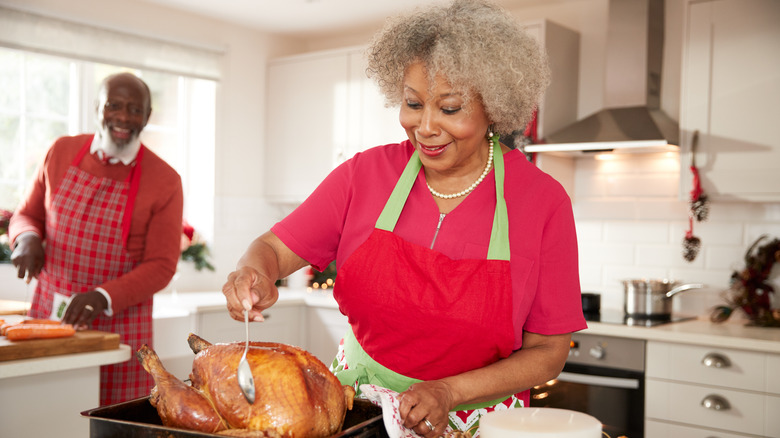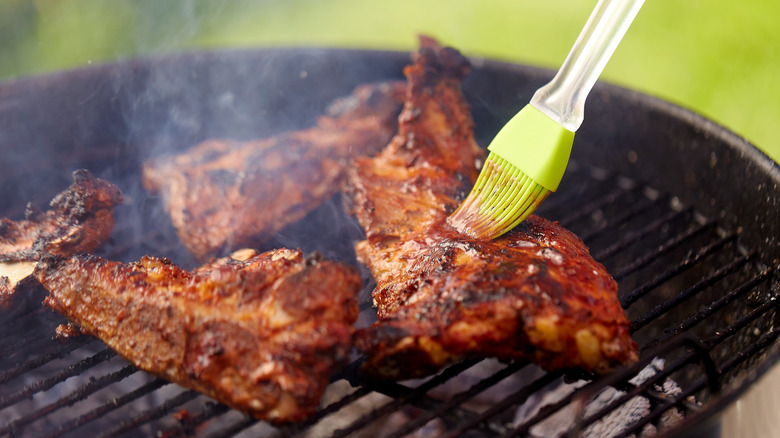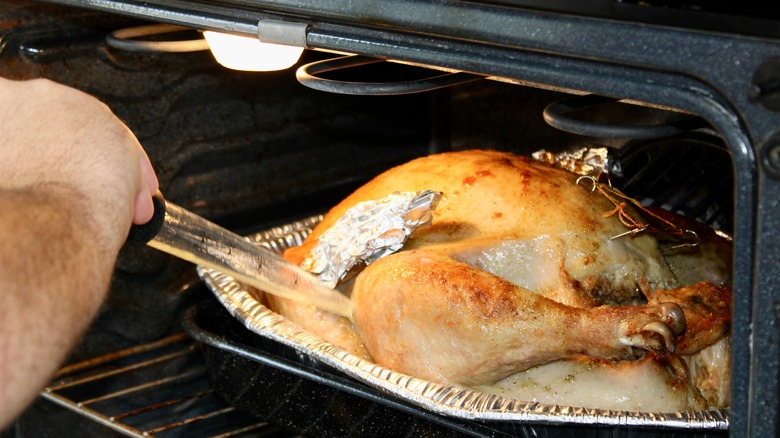When Should You Use A Basting Brush Or Basting Bulb?
You've probably seen the word "baste" in everything from cookbooks to commercials for food. According to Rouxbe, basting is where you pour either liquid or melted fat over the surface of the meat you're preparing, such as turkey, ham, or roast beef. Basting not only gives the meat extra flavor but also helps to prevent the evaporation of moisture (which leads to dry, tough meat) and create an even crust on the exterior of the meat. (Of course, Cook's Illustrated does argue that the difference between a basted dish and a non-basted one is negligible and may not make much as big a difference as you may think).
Unlike brining, which submerges the meat in a liquid or solution for a period of time, basting involves pouring liquids such as pan drippings or stocks over the meat to keep it moist instead of drying out. Think of it like making small adjustments to the meat to keep it moist while you prepare it for baking — you're not trying to drench it, but just keep it "refreshed."
While many tools can be used for basting in theory, the two most popular choices of basting equipment are basting brushes and basting bulbs. Which of these two is the best tool to use, or do both have their own benefits in different situations?
When should you use the basting brush?
A basting brush does exactly what it sounds like: it's a brush meant to spread your choice of basting liquid across the surface of the meat. While using this tool is incredibly simple, when exactly should you use the basting brush? For what dish? Are there certain types of basting liquid or marinade that go particularly well with this brush?
According to Food & Nutrition, basting brushes (alongside pastry and other cooking brushes) have unique characteristics that you should keep in mind, such as the bristles and size. If you have a large brush with lots of bristles, it's best to use it on something with a large surface area like a turkey or ribs. Standard and smaller brushes should be used for smaller meats like chicken breast or ham. The type of bristles should also be considered, as they can be made of different materials such as Teflon or natural fibers. While natural fibers are perfect for any kind of meat, they are too delicate for high-heat environments like a grill. Meanwhile, though plastic-based bristles like silicone can withstand high heat, they can also "damage" softer meats due to their texture.
A basting brush also holds the advantage of being easy to clean. Like any other brush, Epicurious tells us, they just need to be run under hot water and lathered with soap until the bristles are cleaned. Even soaking them in hot sudsy water can do the job.
What are the advantages of a basting bulb?
Don't know what a basting bulb is? You may also know it as a "turkey baster." The bulb, or "baster," is a cross between a syringe and a squirt gun, with a glass or plastic tube that has a rubber suction bulb at one end. You put the open end of the tube into your basting liquid while squeezing the bulb, and then release the bulb to allow liquid to be sucked into the tube. Then, you hold the baster over the meat and squeeze the bulb to pour the juices over it.
The advantage of a basting bulb, says The Spruce Eats, is that it's very efficient at collecting juices, liquids, or marinades from the bottom of the pan. The powerful suction of the bulb draws liquid in much better than the bristles of a brush. However, this ability to hold more liquid comes at a drawback, as the "eyedropper" design of the bulb means that liquid can't be applied evenly onto the surface of the food so much as it is "squirted" out. Unlike the brush, which can be used to "paint" the surface of the meat in juices, the baster is able to "hose" the meat down in its own juices to keep it moist.
If you have a thick type of sauce or liquid, you should focus on the brush for an even coating. A basting bulb is good for collecting juices and redistributing them back into the meat.


